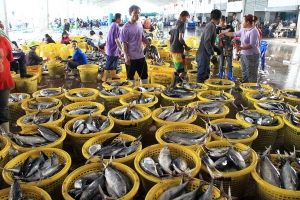Monday, 18 January 2016 07:42
Profiling longtail tuna – the fish, the fisheries and the supply chains
Longtail tuna (Thunnus tonggol) is growing in importance on local and international tuna markets.
As a member of the genus Thunnus, longtail tuna is closely related to the main oceanic tunas such as the bluefin tunas, yellowfin, bigeye and albacore tuna. Yet, it has a very different habitat to these species. It lives in coastal and inshore areas, most commonly in depths less than 50 m. It is one of the neritic tunas (neritic: near shore).
AsiaPacific-FishWatch has compiled a profile of longtail tuna. This species is only found in the Indo-West-Pacific region, where catches match those of bigeye and albacore tuna. For landings, the top eight countries are Iran, Indonesia, Malaysia, Thailand, Oman, India, Pakistan and Yemen. Given these key countries, not surprisingly, the Indian Ocean Tuna Commission and the Southeast Asian Fisheries Development Center pay more management attention to longtail tuna than does the Western and Central Pacific Fisheries Commission.
Here are some key facts about longtail tuna, although much remains to be discovered about this species:
- Limited genetic studies indicate at least two stocks – one in coastal northwest India and one in the South China Sea. More studies are required to define the structure of stocks and remove uncertainty over which units to use for stock assessments.
- Full regional stock assessments are not available. Several local assessments predict the longtail tuna fishery will reach overfished status under the current fishing pressure. No longtail tuna fishery has received certification of sustainability.
- Most longtail tuna are caught in gillnets, purse seines and troll lines. Usually, the fish are caught in multi-species fisheries, making management of this species difficult. Accurate catch data are difficult to collect.
- Longtail tuna is sold canned, smoked and fresh, including as sashimi, in domestic markets and on the global market. Longtail tuna canning facilities are located in India, Indonesia, Iran, and Thailand and are supplied with fish captured primarily from purse seines.
- Longtail tuna is an important recreational fishing species in Australia and Oman.
- Consumer guides have been inconsistent, partly due to the large data gaps for longtail tuna.
Find out more about longtail tuna by exploring the pages of our profile - Quick Facts, Sustainability, Production, Supply Chains & Markets, Environment & Climate, and Biology.
The profiles were written by an expert team: Duncan Leadbitter, Shane Griffiths, Demian Willette and Thomas Nugroho, and peer reviewed by many other experts (see: Contributors & Reviewers).














